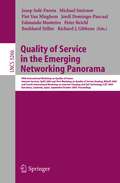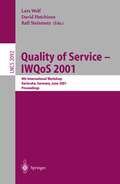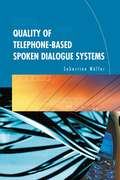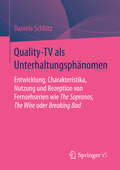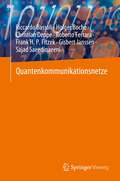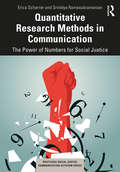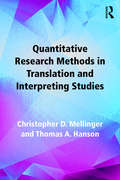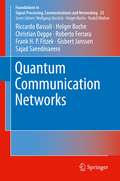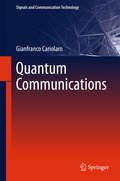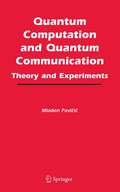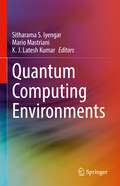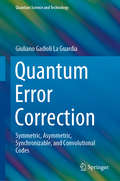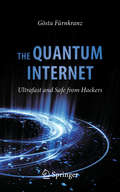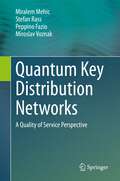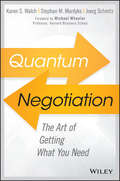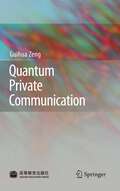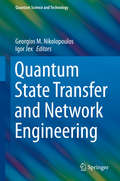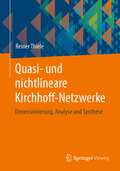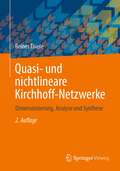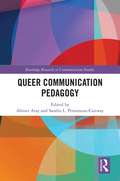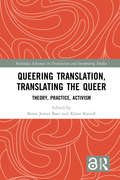- Table View
- List View
Quality of Service in the Emerging Networking Panorama: 5th International Workshop on Quality of Future Internet Services, QofIS 2004, and WQoSR 2004 and ICQT 2004, Barcelona, Spain, September 29- October 1, 2004, Proceedings (Lecture Notes in Computer Science #3266)
by Josep Solé-Pareta Michael Smirnov Piet Van Mieghem Jordi Domingo-Pascual Edmundo Monteiro Peter Reichl Burkhard Stiller Richard J. GibbensQuality of Service - IWQoS 2001: 9th International Workshop Karlsruhe, Germany, June 6-8, 2001. Proceedings (Lecture Notes in Computer Science #2092)
by Lars Wolf David Hutchison Ralf SteinmetzWelcome to IWQoS2001 in Karlsruhe! Quality of Service is a very active research field, especially in the networking community. Research in this area has been going on for some time, with results getting into development and finally reaching the stage of products. Trends in research as well as a reality check will be the purpose of this Ninth InternationalW orkshopo n Quality of Service. IWQoS isa ver y successful seriesof workshops and has established itself as one of the premier forums for the presentation and discussion of new research and ideas on QoS. The importance of this workshop series is also reflected in the large number of excellents ubmissions. Nearly 150 papers from all continents were submitted to the workshop, about a fifth of these being short papers. The program committee were very pleased witht he quality of the submissions andh ad the difficult task of selecting the relatively small number of papers which could be accepted for IWQoS2001. Due to the tough competition, many very good papers had to be rejected.
Quality of Telephone-Based Spoken Dialogue Systems
by Sebastian MöllerQuality of Telephone-Based Spoken Dialogue Systems is a systematic overview of assessment, evaluation, and prediction methods for the quality of services such as travel and touristic information, phone-directory and messaging, or telephone-banking services. A new taxonomy of quality-of-service is presented which serves as a tool for classifying assessment and evaluation methods, for planning and interpreting evaluation experiments, and for estimating quality. A broad overview of parameters and evaluation methods is given, both on a system-component level and for a fully integrated system. Three experimental investigations illustrate the relationships between system characteristics and perceived quality. The resulting information is needed in all phases of system specification, design, implementation, and operation. Although Quality of Telephone-Based Spoken Dialogue Systems is written from the perspective of an engineer in telecommunications, it is an invaluable source of information for professionals in signal processing, communication acoustics, computational linguistics, speech and language sciences, human factor design and ergonomics
Quality-TV als Unterhaltungsphänomen: Entwicklung, Charakteristika, Nutzung und Rezeption von Fernsehserien wie The Sopranos, The Wire oder Breaking Bad
by Daniela SchlützAusgangspunkt des Buches ist die Auseinandersetzung mit sogenannten Qualitätsserien als prototypische Produkte des Fernsehens im Zeitalter der kulturellen Konvergenz. Es wird angenommen, dass Qualitätsunterhaltung eine besondere kulturell gebundene, komplexe und bereichernde Rezeptionserfahrung ermöglicht. Sie dient – so das Argument – daher als Nachfragetreiber in einer direkten Produkt-KundInnen-Beziehung. Die Besonderheit des Buches besteht in der Integration unterschiedlicher kommunikations- und medienwissenschaftlicher, medienpsychologischer aber auch ökonomischer Ansätze im Modell des Quality-TV-Unterhaltungserlebens (QTV-UE). Ziel ist ein umfassenderes Verständnis des Wechselspiels von Produktion, Allokation und Rezeption qualitativ hochwertiger, unterhaltsamer Kreativgüter.
Quantenkommunikationsnetze
by Riccardo Bassoli Holger Boche Christian Deppe Roberto Ferrara Frank H. Fitzek Gisbert Janssen Sajad SaeedinaeeniDieses Buch bietet ein Tutorial über Quantenkommunikationsnetze. Die Autoren erörtern aktuelle Paradigmenwechsel in Kommunikationsnetzen, die erforderlich sind, um die einfachen Transportkonzepte der vorherrschenden Netze um Rechen- und Speicherfunktionen zu ergänzen. Sie zeigen, wie diese "softwarisierten" Lösungen neue Wege beschreiten, um Latenzzeiten zu reduzieren und die Ausfallsicherheit zu erhöhen. Die Autoren erörtern, wie diese Lösungen trotz der ihnen innewohnenden Probleme aufgrund der eingeführten Rechenlatenz und des Energieverbrauchs durch hybride klassisch-quantische Kommunikationsnetze gelöst werden können. Das Buch bringt Quantennetzwerke, Quanteninformationstheorie, Quantencomputer und Quantensimulation zusammen.
Quantitative Research Methods in Communication: The Power of Numbers for Social Justice (Routledge Social Justice Communication Activism Series)
by Erica Scharrer Srividya RamasubramanianThis textbook is an advanced introduction to quantitative methods for students in communication and allied social science disciplines that focuses on why and how to conduct research that contributes to social justice. Today’s researchers are inspired by the potential for scholarship to make a difference for society, to push toward more just and equitable ends, and to engage in dialogue with members of the public so that they can make decisions about how to navigate the social, cultural, and political world equipped with accurate, fair, and up-to-date knowledge. This book illustrates the mechanics and the meaning behind quantitative research methods by illustrating each step in the research design process with research addressing questions of social justice. It provides practical guidance for researchers who wish to engage in the transformation of structures, practices, and understandings in society through community and civic engagement and policy formation. It contains step-by-step guidance in quantitative methods—from conceptualization through all the stages of execution of a study, including providing a detailed guide for statistical analysis—and demonstrates how researchers can engage with social justice issues in systematic, rigorous, ethical, and meaningful ways. This text serves as a core or supplementary textbook for graduate and advanced undergraduate courses in research methods for communication and social sciences and fills a gap for a methods text that is responsive to the desire of scholars to conduct socially impactful research.
Quantitative Research Methods in Communication: The Power of Numbers for Social Justice (Routledge Social Justice Communication Activism Series)
by Erica Scharrer Srividya RamasubramanianThis textbook is an advanced introduction to quantitative methods for students in communication and allied social science disciplines that focuses on why and how to conduct research that contributes to social justice. Today’s researchers are inspired by the potential for scholarship to make a difference for society, to push toward more just and equitable ends, and to engage in dialogue with members of the public so that they can make decisions about how to navigate the social, cultural, and political world equipped with accurate, fair, and up-to-date knowledge. This book illustrates the mechanics and the meaning behind quantitative research methods by illustrating each step in the research design process with research addressing questions of social justice. It provides practical guidance for researchers who wish to engage in the transformation of structures, practices, and understandings in society through community and civic engagement and policy formation. It contains step-by-step guidance in quantitative methods—from conceptualization through all the stages of execution of a study, including providing a detailed guide for statistical analysis—and demonstrates how researchers can engage with social justice issues in systematic, rigorous, ethical, and meaningful ways. This text serves as a core or supplementary textbook for graduate and advanced undergraduate courses in research methods for communication and social sciences and fills a gap for a methods text that is responsive to the desire of scholars to conduct socially impactful research.
Quantitative Research Methods in Translation and Interpreting Studies
by Christopher Mellinger Thomas A. HansonQuantitative Research Methods in Translation and Interpreting Studies encompasses all stages of the research process that include quantitative research methods, from conceptualization to reporting. In five parts, the authors cover: • sampling techniques, measurement, and survey design; • how to describe data; • how to analyze differences; • how to analyze relationships; • how to interpret results. Each part includes references to additional resources and extensive examples from published empirical work. A quick reference table for specific tests is also included in the appendix. This user-friendly guide is the essential primer on quantitative methods for all students and researchers in translation and interpreting studies. Accompanying materials are available online, including step-by-step walkthroughs of how analysis was conducted, and extra sample data sets for instruction and self study: https://www.routledge.com/9781138124967. Further resources for Translation and Interpreting Studies are available on the Routledge Translation Studies Portal: http://cw.routledge.com/textbooks/translationstudies.
Quantitative Research Methods in Translation and Interpreting Studies
by Christopher Mellinger Thomas A. HansonQuantitative Research Methods in Translation and Interpreting Studies encompasses all stages of the research process that include quantitative research methods, from conceptualization to reporting. In five parts, the authors cover: • sampling techniques, measurement, and survey design; • how to describe data; • how to analyze differences; • how to analyze relationships; • how to interpret results. Each part includes references to additional resources and extensive examples from published empirical work. A quick reference table for specific tests is also included in the appendix. This user-friendly guide is the essential primer on quantitative methods for all students and researchers in translation and interpreting studies. Accompanying materials are available online, including step-by-step walkthroughs of how analysis was conducted, and extra sample data sets for instruction and self study: https://www.routledge.com/9781138124967. Further resources for Translation and Interpreting Studies are available on the Routledge Translation Studies Portal: http://cw.routledge.com/textbooks/translationstudies.
Quantum Communication Networks (Foundations in Signal Processing, Communications and Networking #23)
by Frank H. Fitzek Holger Boche Christian Deppe Riccardo Bassoli Roberto Ferrara Gisbert Janssen Sajad SaeedinaeeniThis book provides a tutorial on quantum communication networks. The authors discuss current paradigm shifts in communication networks that are needed to add computing and storage to the simple transport ideas of prevailing networks. They show how these ‘softwarized’ solutions break new grounds to reduce latency and increase resilience. The authors discuss how even though these solutions have inherent problems due to introduced computing latency and energy consumption, the problems can be solved by hybrid classical-quantum communication networks. The book brings together quantum networking, quantum information theory, quantum computing, and quantum simulation.
Quantum Communications (Signals and Communication Technology)
by Gianfranco CariolaroThis book demonstrates that a quantum communication system using the coherent light of a laser can achieve performance orders of magnitude superior to classical optical communicationsQuantum Communications provides the Masters and PhD signals or communications student with a complete basics-to-applications course in using the principles of quantum mechanics to provide cutting-edge telecommunications. Assuming only knowledge of elementary probability, complex analysis and optics, the book guides its reader through the fundamentals of vector and Hilbert spaces and the necessary quantum-mechanical ideas, simply formulated in four postulates. A turn to practical matters begins with and is then developed by:development of the concept of quantum decision, emphasizing the optimization of measurements to extract useful information from a quantum system;general formulation of a transmitter–receiver systemparticular treatment of the most popular quantum communications systems—OOK, PPM, PSK and QAM;more realistic performance evaluation introducing thermal noise and system description with density operators;consideration of scarce existing implementations of quantum communications systems and their difficulties with suggestions for future improvement; andseparate treatment of quantum information with discrete and continuous states.Quantum Communications develops the engineering student’s exposure to quantum mechanics and shows physics students that its theories can have practically beneficial application in communications systems. The use of example and exercise questions (together with a downloadable solutions manual for instructors, available from http://extras.springer.com/) will help to make the material presented really sink in for students and invigorate subsequent research.
Quantum Computation and Quantum Communication: Theory and Experiments
by Mladen PavicicThe field of quantum computing has experienced rapid development and many different experimental and theoretical groups have emerged worldwide.This book presents the key elements of quantum computation and communication theories and their implementation in an easy-to-read manner for readers coming from physics, mathematics and computer science backgrounds. Integrating both theoretical aspects and experimental verifications of developing quantum computers, the author explains why particular mathematical methods, physical models and realistic implementations might provide critical steps towards achieving the final goal - constructing quantum computers and quantum networks. The book serves as an excellent introduction for new researchers and also provides a useful review for specialists in the field
Quantum Computing Environments
by Sitharama S. Iyengar Mario Mastriani K. J. Latesh KumarThis book explains the evolution of techniques and strategies in quantum computing, discussing the digital transition towards the quantum computing application in various sectors. The book provides a comprehensive insight into the quantum mechanics and quantum computing techniques and tools and how they have evolved and the impacted in supporting and flourishing business during the quantum computing era. This book includes chapters that discuss the most primitive quantum schemes to the most recent use of Internet, finance and radar technology, thus leveraging greater use of new technologies like security and Internet and others. The content is relevant for an audience that is involved in the research and development of advanced quantum systems. It gives the industry, researchers, and students interested in learning the various quantum computing sectors with the necessary information and tools that can be used to research, design and develop advanced quantum computing systems and techniques.
Quantum Error Correction: Symmetric, Asymmetric, Synchronizable, and Convolutional Codes (Quantum Science and Technology)
by Giuliano Gadioli La GuardiaThis text presents an algebraic approach to the construction of several important families of quantum codes derived from classical codes by applying the well-known Calderbank-Shor-Steane (CSS), Hermitian, and Steane enlargement constructions to certain classes of classical codes. In addition, the book presents families of asymmetric quantum codes with good parameters and provides a detailed description of the procedures adopted to construct families of asymmetric quantum convolutional codes.Featuring accessible language and clear explanations, the book is suitable for use in advanced undergraduate and graduate courses as well as for self-guided study and reference. It provides an expert introduction to algebraic techniques of code construction and, because all of the constructions are performed algebraically, it enables the reader to construct families of codes, rather than only codes with specific parameters. The text offers an abundance of worked examples, exercises, and open-ended problems to motivate the reader to further investigate this rich area of inquiry. End-of-chapter summaries and a glossary of key terms allow for easy review and reference.
The Quantum Internet: Ultrafast and Safe from Hackers
by Gösta FürnkranzThe internet can look forward to a fantastic future! With new quantum technology, hacker-proof exchange of information and ultrafast data processing will become possible. The basis for these is Albert Einstein's "quantum spook". We are not dealing here with sorcery, but with hard-core science. This book undertakes a fascinating journey through the world of our quantum future - from the first "quantum satellite" to high-security internet, the quantum cloud and beyond, to partly futuristic applications. The author guides the reader through the basic ideas of quantum physics, explains the concepts of quantum computers, quantum cryptography, and quantum teleportation, and then establishes their relationship to the quantum Internet. Special attention is paid not only to the technical challenges involved, but also to the likely effects on society. Alongside examples of implementation, the author intersperses delightful anecdotes, which bring the story to life. With this book you will learn how quantum physics can revolutionize the internet! "... in lively prose the author presents the current state of research in its whole breadth and splendour – valuable and entertaining reading!” Rupert Ursin, Group Leader and Vice Director of the Institute for Quantum Optics and Quantum Information, Vienna
Quantum Key Distribution Networks: A Quality of Service Perspective
by Miralem Mehic Stefan Rass Peppino Fazio Miroslav VoznakThis book focuses on practical implementation details, telecommunication techniques, security and technology challenges and approaches to implementing quantum technology in modern telecommunication systems. The authors use their extensive practical academic and industrial experience in network technologies and provide details from international projects in quantum cryptography in which they actively participate. Using a variety of examples, analogies, illustrations, tables, and features from practical quantum network realizations, the authors provide a unique view of quantum technology from an engineering telecommunication standpoint, allowing the reader to identify the advantages and challenges of quantum technology.This book also addresses challenges posed by quantum technology such as network organization, passive and active eavesdropping, and future trends in QKD such as Software Defined Networking (SDN) with QKD and application QKD in 5G networks. It is conceived through eight chapters by treating the following thematic units separately: Fundamentals of Quantum Key Distribution, QoS architecture/mode, QoS MAC layer, QoS signaling techniques for key management and session negotiation purpose and QoS routing protocols that minimize the consumption of key material through the equitable utilization of network resources when finding an optimal path. Through numerous information on practical solutions, simulation examples, illustrations, and analysis, readers can easily distinguish the specificity of quantum technology and understand the challenges and methods of practical implementation of quantum cryptography in common telecommunications standards. Researchers working in quantum technology and applied networking security as well as advanced-level students studying computer science and electrical engineering will benefit from this book. Professionals working within these related fields will also benefit from this book.
Quantum Negotiation: The Art of Getting What You Need
by Karen S. Walch Stephan M. Mardyks Joerg SchmitzMaster the art of getting what you need with a more collaborative approach to negotiation Quantum Negotiation is a handbook for getting what you need using a mindset and behaviors based on a refreshingly expansive perspective on negotiation. Rather that viewing every negotiation as an antagonistic and combative relationship, this book shows you how to move beyond the traditional pseudo win-win to construct a deal in which all parties get what they need. By exploring who we are as negotiators in the context of social conditioning, this model examines the cognitive, psychological, social, physical, and spiritual aspects of negotiation to help you produce more sustainable, prosperous, and satisfying agreements. We often think of negotiation as taking place in a boardroom, a car dealership, or any other contract-centered situation; in reality, we are negotiating every time we ask for something we need or want. Building more robust negotiation behaviors that resonate beyond the boardroom requires a deep engagement with others and a clear mindset of interdependence. This book helps you shift your perspective and build these important skills through a journey of discovery, reflection, and action. Rethink your assumptions about negotiations, your self-perception, your counterpart, and the overall relationship Adopt new tools that clarify what you want, why you need it, and how your counterpart can also get what they want and need Challenge fundamental world views related to negotiation, and shift from adversarial to engaging and satisfying Understand the unseen forces at work in any negotiation, and prevent them from derailing your success In the interest of creating an environment that elevates everyone’s participation and assists them in reaching their full potential, Quantum Negotiation addresses the reality of hardball and coercion with a focus on engaging the human spirit to create new opportunities and resources.
Quantum Negotiation: The Art of Getting What You Need
by Karen S. Walch Stephan M. Mardyks Joerg SchmitzMaster the art of getting what you need with a more collaborative approach to negotiation Quantum Negotiation is a handbook for getting what you need using a mindset and behaviors based on a refreshingly expansive perspective on negotiation. Rather that viewing every negotiation as an antagonistic and combative relationship, this book shows you how to move beyond the traditional pseudo win-win to construct a deal in which all parties get what they need. By exploring who we are as negotiators in the context of social conditioning, this model examines the cognitive, psychological, social, physical, and spiritual aspects of negotiation to help you produce more sustainable, prosperous, and satisfying agreements. We often think of negotiation as taking place in a boardroom, a car dealership, or any other contract-centered situation; in reality, we are negotiating every time we ask for something we need or want. Building more robust negotiation behaviors that resonate beyond the boardroom requires a deep engagement with others and a clear mindset of interdependence. This book helps you shift your perspective and build these important skills through a journey of discovery, reflection, and action. Rethink your assumptions about negotiations, your self-perception, your counterpart, and the overall relationship Adopt new tools that clarify what you want, why you need it, and how your counterpart can also get what they want and need Challenge fundamental world views related to negotiation, and shift from adversarial to engaging and satisfying Understand the unseen forces at work in any negotiation, and prevent them from derailing your success In the interest of creating an environment that elevates everyone’s participation and assists them in reaching their full potential, Quantum Negotiation addresses the reality of hardball and coercion with a focus on engaging the human spirit to create new opportunities and resources.
Quantum Private Communication
by Guihua ZengQuantum Private Communication covers the fundamentals of the areas of secure communication, quantum cryptography, quantum communication, and their physical implementation with applications. The book appears in a timely manner for an emerging field at the crossroad of classic private communication and quantum physics. Graduate students and scientists alike in communication engineering, computer science, electronic engineering, physics and mathematics will benefit from the book. Professor Guihua Zeng teaches and conducts research at the Department of Electronic Engineering of Shanghai Jiao Tong University and spent an Alexander von Humboldt Fellowship at the University of Freiburg, Germany.
Quantum State Transfer and Network Engineering (Quantum Science and Technology)
by Georgios M. Nikolopoulos Igor JexFaithful communication is a necessary precondition for large-scale quantum information processing and networking, irrespective of the physical platform. Thus, the problems of quantum-state transfer and quantum-network engineering have attracted enormous interest over the last years, and constitute one of the most active areas of research in quantum information processing. The present volume introduces the reader to fundamental concepts and various aspects of this exciting research area, including links to other related areas and problems. The implementation of state-transfer schemes and the engineering of quantum networks are discussed in the framework of various quantum optical and condensed matter systems, emphasizing the interdisciplinary character of the research area. Each chapter is a review of theoretical or experimental achievements on a particular topic, written by leading scientists in the field. The volume aims at both newcomers as well as experienced researchers.
Quasi- und nichtlineare Kirchhoff-Netzwerke: Dimensionierung, Analyse und Synthese
by Reiner ThieleDas Buch vermittelt neuartige Analyse- und Syntheseverfahren für quasi- und nichtlineare Kirchhoff-Netzwerke. Hierzu verwendet der Autor als Unternetzwerke gewöhnliche Widerstände, Kondensatoren, Spulen, Übertrager, Transistoren oder Dioden sowie die sogenannten pathologischen Unternetzwerke Nullator und Norator. Zur Analyse oder Synthese erfolgt eine Zerlegung der Gleichungen zur Beschreibung des Klemmenverhaltens in die u-i-Relationen realisierbarer Unternetzwerke sowie in Strukturgleichungen nach Kirchhoff. Dazu kreiert Reiner Thiele neue nichtlineare Transistor- bzw. Dioden-Modelle. Außerdem zeigt er, wie durch die Applikation von Klemmen-Äquivalenzen praxisrelevante elektrische oder elektronische Schaltungen entstehen.
Quasi- und nichtlineare Kirchhoff-Netzwerke: Dimensionierung, Analyse und Synthese
by Reiner ThieleDas Buch vermittelt neuartige Analyse- und Syntheseverfahren für quasi- und nichtlineare Kirchhoff-Netzwerke. Hierzu verwendet der Autor als Unternetzwerke gewöhnliche Widerstände, Kondensatoren, Spulen, Übertrager, Transistoren oder Dioden sowie die sogenannten pathologischen Unternetzwerke Nullator und Norator. Zur Analyse oder Synthese erfolgt eine Zerlegung der Gleichungen zur Beschreibung des Klemmenverhaltens in die u-i-Relationen realisierbarer Unternetzwerke sowie in Strukturgleichungen nach Kirchhoff. Dazu kreiert Reiner Thiele neue nichtlineare Transistor- bzw. Dioden-Modelle. Außerdem zeigt er, wie durch die Applikation von Klemmen-Äquivalenzen praxisrelevante elektrische oder elektronische Schaltungen entstehen.
Queer Communication Pedagogy (Routledge Research in Communication Studies)
by Ahmet Atay Sandra L. Pensoneau-ConwayThis book addresses queer issues and current events from a communication perspective to articulate a queer communication pedagogy. Through putting communication pedagogy and queer studies into dialogue, the book investigates how queer theory and critical communication pedagogy intersect in pedagogical spaces. The chapters identify institutional and educational barriers, oppressions, and issues pertaining to queer lives in the context of higher education. Using a variety of critical methodological approaches (including dialogic methods, autoethnography, performative writing, and visual methods), each chapter theorizes a queer communication pedagogy, and offers a path toward and innovative ideas about materializing queer communication pedagogy as a disciplinary endeavor. This book will be of interest to scholars, graduate students, and upper-level undergraduate students in Communication Studies, Critical Communication Pedagogy, Intercultural Communication, Higher Education, Public Pedagogy, and Queer Studies, and Critical/Cultural Studies.
Queer Communication Pedagogy (Routledge Research in Communication Studies)
by Ahmet Atay Sandra L. Pensoneau-ConwayThis book addresses queer issues and current events from a communication perspective to articulate a queer communication pedagogy. Through putting communication pedagogy and queer studies into dialogue, the book investigates how queer theory and critical communication pedagogy intersect in pedagogical spaces. The chapters identify institutional and educational barriers, oppressions, and issues pertaining to queer lives in the context of higher education. Using a variety of critical methodological approaches (including dialogic methods, autoethnography, performative writing, and visual methods), each chapter theorizes a queer communication pedagogy, and offers a path toward and innovative ideas about materializing queer communication pedagogy as a disciplinary endeavor. This book will be of interest to scholars, graduate students, and upper-level undergraduate students in Communication Studies, Critical Communication Pedagogy, Intercultural Communication, Higher Education, Public Pedagogy, and Queer Studies, and Critical/Cultural Studies.
Queering Translation, Translating the Queer: Theory, Practice, Activism (Routledge Advances in Translation and Interpreting Studies)
by Brian James Baer Klaus KaindlThis groundbreaking work is the first full book-length publication to critically engage in the emerging field of research on the queer aspects of translation and interpreting studies. The volume presents a variety of theoretical and disciplinary perspectives through fifteen contributions from both established and up-and-coming scholars in the field to demonstrate the interconnectedness between translation and queer aspects of sex, gender, and identity. The book begins with the editors’ introduction to the state of the field, providing an overview of both current and developing lines of research, and builds on this foundation to look at this research more closely, grouped around three different sections: Queer Theorizing of Translation; Case Studies of Queer Translations and Translators; and Queer Activism and Translation. This interdisciplinary approach seeks to not only shed light on this promising field of research but also to promote cross fertilization between these disciplines towards further exploring the intersections between queer studies and translation studies, making this volume key reading for students and scholars interested in translation studies, queer studies, politics, and activism, and gender and sexuality studies.
